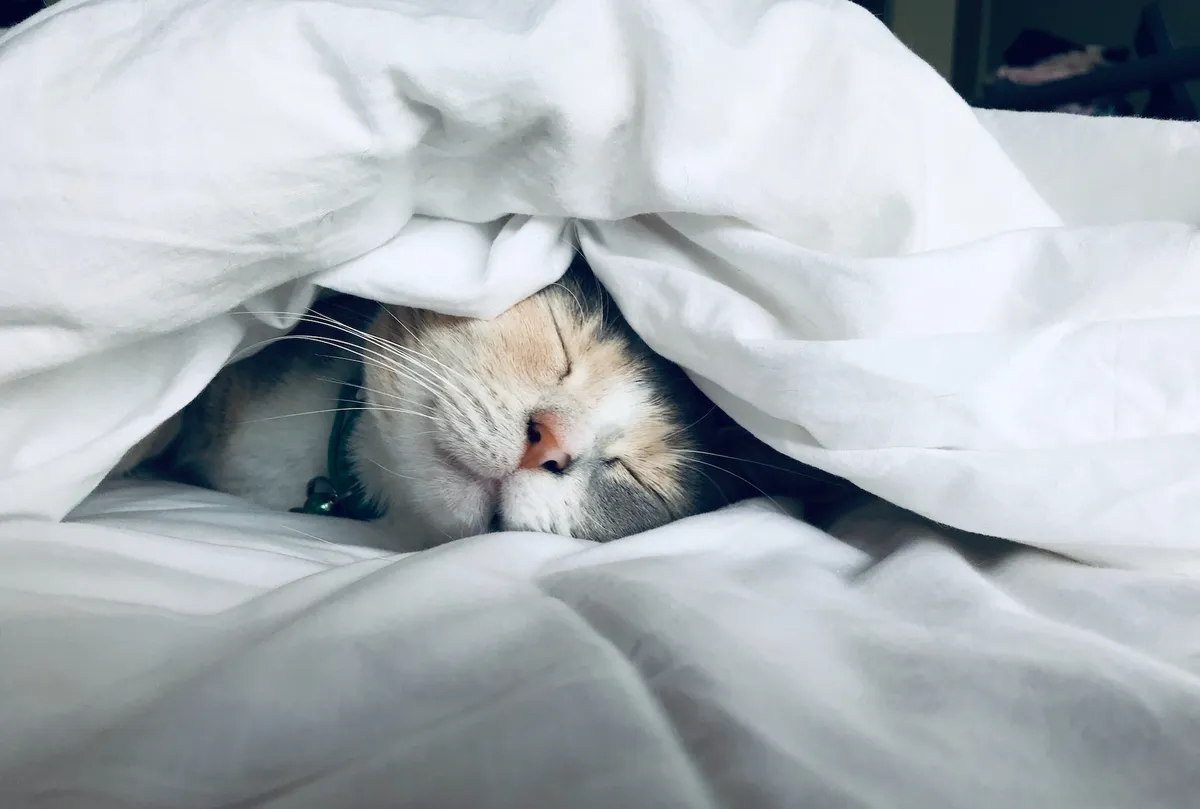Are you constantly tossing and turning at night, feeling too hot to sleep comfortably? The problem might be lying right under your nose, or rather, right over your body – your comforter. While traditional comforters provide warmth and comfort, they can often lead to overheating. The solution? Cooling comforters.
These innovative bedding essentials are designed to keep you cool and comfortable all night long. In this guide, we’ll delve into the different types of cooling comforters, their key features, and how to choose the best cooling comforters for hot sleepers like you.
Table of Contents
How Do Cooling Comforters Work?
Cooling comforters work by leveraging advanced materials and construction techniques to regulate temperature and promote airflow. They are designed to prevent heat buildup, which is a common issue with traditional comforters.
The cooling process begins with the fill material. In cooling comforters, the fill is often lightweight and breathable, allowing air to circulate freely. This prevents heat from being trapped within the comforter. Some cooling comforters use technologically advanced materials that absorb and release heat, maintaining a consistent temperature throughout the night.
The outer fabric also plays a crucial role. Materials like cotton or bamboo-derived fabrics are often used due to their breathability. These fabrics allow air to pass through, further enhancing the cooling effect.
Additionally, many cooling comforters have moisture-wicking properties. This means they can draw sweat away from the body, keeping you dry and comfortable. This is particularly beneficial for those who tend to sweat during sleep.
In essence, cooling comforters work by combining breathable materials, advanced technology, and smart design to create a sleep environment that remains cool and comfortable throughout the night.

Types of Cooling Comforters
Down Alternative Cooling Comforters
Down alternative cooling comforters are a popular choice for those who want the plushness of down without the heat. These comforters use synthetic materials such as polyester or cotton, which mimic the fluffiness of down but allow more air circulation.
Pros
- Hypoallergenic, suitable for those with allergies.
- More breathable than traditional down comforters.
- Generally less expensive than down comforters.
Cons
- May not be as durable as down comforters.
- Not as insulating, which may not be ideal for colder climates.
Why People Choose Down Alternative Cooling Comforters
Down alternative comforters are chosen for their affordability and hypoallergenic properties. They offer the plushness of down without the heat, making them a popular choice for those living in warmer climates or those who tend to overheat during sleep.
Care and Maintenance
Down alternative comforters are typically machine washable, making them easy to care for. Always follow the manufacturer’s care instructions to maintain the longevity of the comforter.
Bamboo-Derived Cooling Comforters
Bamboo-derived cooling comforters are known for their exceptional breathability and moisture-wicking properties. Bamboo is a natural material that is highly breathable and has the ability to wick away moisture, keeping you dry and comfortable throughout the night.
Pros
- Highly breathable and excellent moisture-wicking properties.
- Hypoallergenic and resistant to dust mites and mold.
- Soft and luxurious feel.
Cons
- Can be more expensive than other types of cooling comforters.
- May require more careful washing and drying to maintain the quality of the fabric.
Why People Choose Bamboo-Derived Cooling Comforters
Bamboo-derived comforters are chosen for their superior breathability and moisture-wicking properties. They are also a sustainable choice, as bamboo is a renewable resource.
Care and Maintenance
Bamboo-derived comforters typically require machine washing on a gentle cycle and air drying. Always check the manufacturer’s care instructions to ensure proper maintenance.
Technologically-Advanced Cooling Comforters
Technologically-advanced cooling comforters utilize special fabrics and materials designed to regulate temperature and wick away moisture. These comforters often incorporate phase change materials, which absorb and release heat to maintain a consistent temperature.
Pros
- Utilize special fabrics and materials designed to regulate temperature.
- Excellent for those who sleep hot or live in warm climates.
- Often incorporate advanced features like phase change materials.
Cons
- Can be more expensive due to the advanced technology used.
- Care instructions can vary, requiring more attention to maintain.
Why People Choose Technologically-Advanced Cooling Comforters
Technologically-advanced cooling comforters are chosen for their superior temperature regulation capabilities. They are ideal for those who sleep hot or live in warm climates.
Care and Maintenance
Care instructions for technologically-advanced cooling comforters can vary, so it’s important
to check the manufacturer’s guidelines. Some may require professional cleaning, while others can be machine washed.
Key Features to Consider When Choosing Cooling Comforters
Fill Power
When choosing a cooling comforter, consider the fill power. A lower fill power around 400 or below is generally better for cooling comforters as it allows more air circulation.
Fill Weight
A lighter fill weight, typically less than 30 ounces, reduces heat retention.
Outer Fabric
The outer fabric should be breathable, with cotton or bamboo-derived materials being excellent choices.
Moisture Wicking
Look for comforters with moisture-wicking properties, especially if you tend to sweat during sleep.
Size
Lastly, ensure the size of the comforter matches the size of your bed for optimal function and aesthetics.
Revitalizing Your Sleep With Other Cooling Products
Maintaining a cool, comforting environment during sleep is essential, especially if you’re grappling with night sweats. Here are a few game-changing products that can contribute to a more refreshing sleep experience, each contributing a unique aspect to your nighttime comfort:
Cooling Bed Sheets
Your bed sheets can play a pivotal role in managing your sleeping temperature. Seek out bed sheets crafted from breathable, moisture-wicking fabrics like bamboo, linen, or specialized cotton blends. They’re designed to disperse heat and wick away perspiration, providing you with a cooler and drier sleep.
Cooling Mattress
For a comprehensive solution, cooling mattresses are designed to enhance airflow and dissipate heat, thanks to their specialized materials and construction. Built with technology that actively cools down the mattress surface, they’re the ultimate investment for a refreshing night’s sleep.
Cooling Mattress Toppers
A cooling mattress topper is more than just a layer of comfort—it’s an innovative tool in managing body temperature. By incorporating temperature-regulating materials, these toppers can significantly reduce the heat retained during sleep, offering a less intrusive solution than changing your entire mattress.
Cooling Pillows
Cooling pillows, much like their mattress counterparts, are engineered with temperature-regulating materials—think gel-infused memory foam and breathable fabrics. Some come with removable, washable covers made from cooling fabrics, further enhancing your cool, night-long comfort.
Cooling Pajamas
Redefine your night-time routine with cooling pajamas. Made from breathable, moisture-wicking materials, these pajamas regulate your body temperature, providing a layer of comfort that extends beyond your bedding. If night sweats are a concern, these innovative garments are a great solution.
Each of these products offers a unique approach to tackling heat build-up during sleep, transforming your bed into an oasis of cool comfort. Together, they create an environment conducive to a full, undisturbed night’s rest.
Frequently Asked Questions (FAQs)
What is the best type of comforter to stay cool?
The best type of comforter to stay cool largely depends on individual preferences, but technologically-advanced cooling comforters are often highly effective. They use special fabrics and materials designed to regulate temperature and wick away moisture, providing a consistently cool sleep environment.
What fabric is coolest for comforters?
Breathable fabrics like cotton or bamboo-derived materials are typically the coolest for comforters. These fabrics allow air to circulate, preventing heat buildup and promoting a cooler sleep environment.
How much do cooling comforters cost?
The cost of cooling comforters can vary widely depending on the type, size, and brand. On average, you can expect to pay anywhere from $50 for a basic model to over $200 for a high-end, technologically-advanced cooling comforter.
Where can I buy a cooling comforter?
Cooling comforters can be purchased at a variety of retailers, both online and in-store. This includes home goods stores, department stores, and online marketplaces like Amazon. You can also buy directly from many bedding manufacturers’ websites.
What is the best cooling comforter?
The “best” cooling comforter can vary based on individual needs and preferences. However, when considering factors like breathability, moisture-wicking properties, fill power, fill weight, and outer fabric, a technologically-advanced cooling comforter often ranks highly.
What is fill power and why is it important in a cooling comforter?
Fill power refers to the volume of space one ounce of down (or a down alternative) fills in cubic inches. In a cooling comforter, a lower fill power is generally better as it allows more air circulation, which helps to dissipate heat and keep the sleeper cool.
How does fill weight affect the cooling properties of a comforter?
Fill weight refers to the total amount of fill used in the comforter. A lighter fill weight is typically better for a cooling comforter as it reduces heat retention, allowing the comforter to stay cool.
What types of outer fabric are best for cooling comforters?
The best types of outer fabric for cooling comforters are those that are breathable and moisture-wicking. This often includes natural fibers like cotton or bamboo-derived materials, which allow air to circulate freely and wick away moisture, promoting a cooler and more comfortable sleep environment.
Conclusion
Choosing the right cooling comforter can significantly improve your sleep quality by regulating temperature and reducing overheating. With the right information and understanding of your personal needs, you can find a cooling comforter that provides comfort without the sweat.
